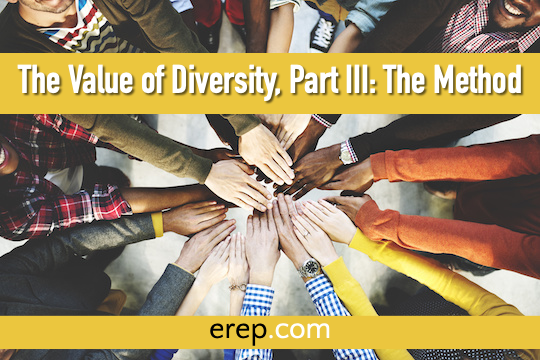The Value of Diversity Part III: The Method
- By
- Steve Williamson, VP Digital Marketing and Content, eRep, Inc.
- Posted
- Monday, March 17, 2025

This is the third and final article of a three-part series where we discuss the reason, value, and method for achieving workplace diversity. In the first article, we discuss the quantitative metrics showing how diversity adds value to your organization.
Escaping a pattern of uniformity can feel like the breaking of an old habit. Old habits can be broken by actively engaging in different behavior. Do you only drive Fords because you only buy Fords?
Excuses come easy. "We only hire caucasian workers because only caucasian candidates have applied." Like a reverse dog whistle, the wording of your job listings might be making it subconsciously clear to non-whites that they need not apply, and you probably aren't even aware it's happening.
"95% of our attorneys are men because there just aren't very many women applying at our firm." Did you know the majority of law school graduates today are women?
These excuses are a form of cognitive bias, a type of mental momentum that keeps them going. They will keep going until you take a deliberate look at the situation, recognize where diversity is absent, and take specific and active steps to break those old habits.
Increasing diversity in hiring takes willful and deliberate effort, but it's not as difficult as it may seem. Let's not forget the benefits of diversity we learned in Part I, "racially diverse teams outperform non-diverse ones by 35%, and teams with equal numbers of men and women earn 41% more."
Abandon the old excuses. Escape the subjective and unconscious momentum of uniformity.
Here are three strategies you can adopt today that will put you on the right track toward embracing diversity within your organization:
- Eliminate location bias by choosing a job listing service that offers broad geographic and demographic coverage.
- Screen candidates based on objective metrics before any of their demographic or other stereotype-or bias-prone information becomes visible.
- Profile the objective characteristics of a top performer, then use that data to match candidates to the role.
Adopting and implementing these three strategies breaks the old habits and momentum of uniformity that is keeping your organization from rising above the median.
Here's a bonus tip. A series of studies outlined here, including one by the University of Ontario, found that relying on algorithms and data to make hiring decisions outperforms human judgment by at least 25%.
→ See Part I of this series to find out what a lack of diversity may be costing you.
All three of these diversity strategies can be accomplished by relying on psychometric assessments in hiring as well as workforce evaluation and reorganization efforts.
Reach candidates with the geographic and demographic coverage you need through job listings services that have national exposure. Choosing a single job board that connects to many others automatically and offers integration with an Applicant Tracking System, or ATS, makes the process seamless and time-efficient.
Rely on objective psychometric data to screen candidates. Compare candidate psychometric data against position profiles to practically eliminate conscious and unconscious biases. This also has the benefit of saving time because you can sort and group candidate lists to efficiently reveal your likely top performers.
The use of objective data is a key component in your effort to embrace diversity.
A wonderful benefit of this approach is that your organization's culture grows organically. Teams thrive in work environments that have this diversity-driven culture. Engagement is increased, and employees have a sense of fulfillment that boosts productivity.
Employees that work for companies who embrace diversity perform better and turnover is reduced. Through the use of objective hiring data provided by psychometric assessments, your organization can be well on its way toward embracing diversity.
Tools
There are a variety of psychometric assessment, job listing, and ATS tools available. As with all tools, some are better than others. Psychometric assessments have been around for decades, such as Myers-Briggs and the DiSC. The Core Values Index is another leading psychometric assessment tool, with key benefits like the highest repeat reliability available (97.7%), low cost (less than $50 per assessment), and ease-of-use (an assessment usually takes about 8 minutes to complete).
The key is to find a system that is integrated. You want a single suite of tools that seamlessly handles the entire hiring and employee evaluation process from start to finish.
Regardless of which tools you choose, reducing the subjective traits of your old hiring methods and placing greater weight on objective data allows diversity to bloom.
This is the final article of a three-part series on diversity in the workforce. Be sure to check out Part I: The Reason, and Part II: The Example.
Go to eRep.com/core-values-index/ to learn more about the CVI or to take the Core Values Index assessment.

Steve Williamson
Innovator/Banker - VP Digital Marketing and Content, eRep, Inc.
Steve has a career in project management, software development and technical team leadership spanning three decades. He is the author of a series of fantasy novels called The Taesian Chronicles (ruckerworks.com), and when he isn't writing, he enjoys cycling and old-school table-top role-playing games.
View additional articles by this contributor
Essentials
Additional Reading
Stay Updated
Employer Account Sign-up
Sign up for an employer account and get these features and functions right away:
- Unlimited Job Listings on eRep.com
- Applicant Search
- Applicant Tracking System (ATS)
- Unlimited Happiness Index employee surveys
- 3 full/comprehensive CVIs™
- No credit card required — no long-term commitment — cancel at any time
Write for eRep
Are you interested in writing for eRep? Read our submission guidelines.
